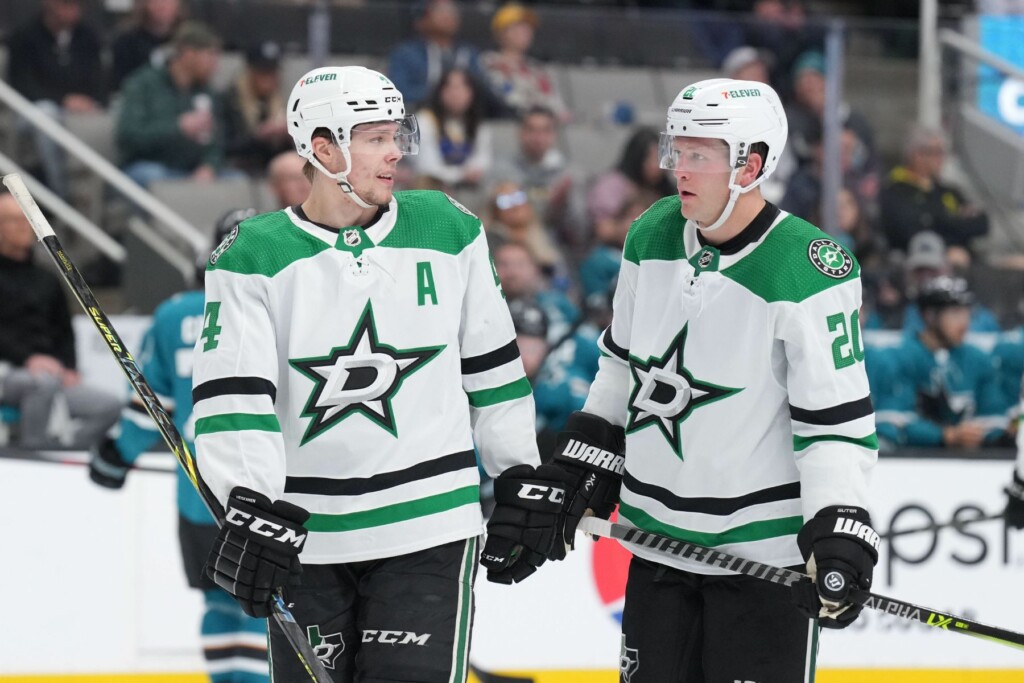The Stars are hitting the crest of the Jim Nill and Joe McDonnell draft wave. Wyatt Johnston arrived ahead of schedule, Thomas Harley’s playoff performance vindicated his additional AHL seasoning, and Jason Robertson finished fourth in Hart Trophy voting at the age of 23. Miro Heiskanen is Miro Heiskanen. The future is bright, with more help on the way. Not since the Stars won the Stanley Cup in 1999 has there been a better time to be a fan of this team.
But fun as it is to see young players come into their own, that youth movement isn’t the team’s identity. Believe it or not, Dallas is one of the 10 oldest teams in the NHL. Joe Pavelski, Ryan Suter, and even Jamie Benn drive up the team’s average age, but you also may not realize that the hot new acquisition, Matt Duchene, is older than familiar veterans such as Radek Faksa. In fact, at 32, Duchene is nearly as close in age to new arrival Craig Smith as he is to Tyler Seguin.
Except Dallas isn’t quite your typical “old team” either. For every guy in his 30s daring Father Time to blink, there’s a phenom standing next to him, or possibly renting a room from him. To wit, here is the complete list of Stars with birthdays from 1995 to ’98: Mason Marchment, Roope Hintz, Sam Steel, and Jake Oettinger. Every other Star is still under 25 or way over it, as you can see here:
The Stars are like two halves of two completely different teams. Dallas has a ton of young talent likely to be featured on a rebuild, but those players are stapled to highly paid thirtysomethings often found on teams reaching the end of their competitive window. Heiskanen, Harley, and Nils Lundkvist, all 23 or younger, regularly partnered with players at least a half decade older than them. It was the same story up front: Benn with Johnston, Pavelski with Robertson. When Oettinger, the franchise goaltender, turned the ripe old age of 24 in December, he essentially entered middle age, at least relative to the rest of the roster.
It’s a narrow path to walk. The right players must step up as others decline, all while the front office navigates the cap. Somehow, it all came together last year. Dallas demonstrated that this sort of “average through polar extremes” approach can work, albeit while being quite fortunate in terms of injury luck on a squad rife with veterans.
This has been part and parcel to Nill’s philosophy dating to his days as assistant general manager of the Detroit Red Wings, working under Ken Holland, the general manager who was the architect of a 25-year playoff streak. But Nill’s mandate in Dallas is to avoid making the same mistakes Holland did toward the end of Detroit’s golden era, when you could see the warning lights on the dashboard shortly after the Red Wings won the Cup in 2008 and returned to the Stanley Cup Finals the next year.
Here’s what the roster looked like in Nill’s final season in Detroit:
Holland was relying on a swath of low-cost skaters in their late 20s to do whatever franchise legends Pavel Datsyuk and Henrik Zetterberg, then in their 30s, couldn’t. When the supporting cast joined Datsyuk and Zetterberg in their 30s, the team fell out of playoff contention. The Red Wings tried to remain competitive, but as their late-round draft picks stopped coming producing, the talent pool was depleted. As a result, the team capsized under the weight of too many highly compensated veterans past their sell-by dates and too few young assets to pick up the slack. Hockey’s most durable playoff franchise has now gone seven years since it last tasted the postseason.
Age is just a number, of course. At 39, Pavelski is producing at a rate better than most players a decade younger than him. But age distribution has a big impact. For instance, the Stars’ playoff roster had an average age of 28.2 years. That was the same number as their conference final opponent, the Vegas Golden Knights—but the teams could not have gotten there in more different ways. While Dallas’s average was a result of wildly different ages—see: the 23-year-old Heiskanen partnering with the 38-year-old Suter—Vegas’s roster was almost entirely composed of players between the ages of 24 and 33. That reflected in the Golden Knights’ play, and the sixth-year expansion franchise already has a Stanley Cup to show for it.
Of course, there’s an obvious downside to that approach: players in that age range tend to be expensive, both to pay and to acquire. This is why Vegas only had four picks in last month’s draft. This is also why Vegas just shipped the extremely useful Reilly Smith out of town for a third-round draft pick. Vegas is going to be fighting the salary cap even after it (presumably) balloons next summer, and the Golden Knights don’t exactly have a ton of young players poised to help keep costs down. Maybe they can keep clicking on all cylinders, but they’ll need more than a little from a whole lot of players to do it. Those players won’t have anyone waiting in the wings behind them either.
In theory, Dallas is better equipped to sustain its roster. But if and when the younger players step up to fill the performance gaps of higher-paid and older veterans, it won’t come a moment too soon. Aside from the 26-year-old Hintz, there are no real impact players bridging the generation gap. The Stars are still squeezing meaningful minutes from the likes of Benn, Seguin, and Pavelski, along with less meaningful ones from players around Hintz’s age, including Marchment and Radek Faksa. The points are almost exclusively coming from the top and the bottom of the age curve on the roster.
In other words, the Stars’ Cup window will most likely be tied to the resiliency of the older players. Last season, Dallas benefited from health among most of its older players and impudently great production from its youth. That’s a great recipe when it works, but there are an awful lot of ways it can go sideways, too. Johnston could have a bit of a sophomore slump. Suter could decline past the point of being useful even on a pair with Heiskanen, and neither Lundkvist nor Lian Bichsel may be ready to take his place. One or both of Logan Stankoven and Mavrik Borque may not be ready to contribute. The struggles of Faksa and Marchment could continue, making their cap hits too onerous to move, should the need arise. In short, the Stars are hoping that the older players continue to be healthy and reliable while the younger ones mature right on schedule. That’s a high-risk game.
Pavelski is 19 years older than Johnston, the aforementioned renter of the upstairs bedroom, and they were two of the most productive Stars relative to their minutes. That is a microcosm of this roster. The Stars are an old team and a young team, sewn together in unlikely harmony. As long as the connective tissue holds together, they can continue to duke it out with Vegas. But once those threads begin to fray, they might be lurching around like Frankenstein’s monster. Or even worse, the Detroit Red Wings.
Author









